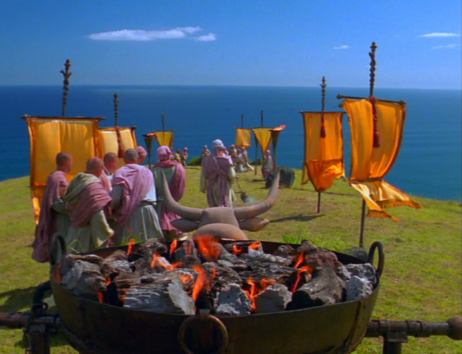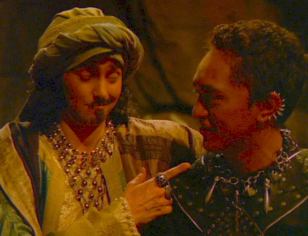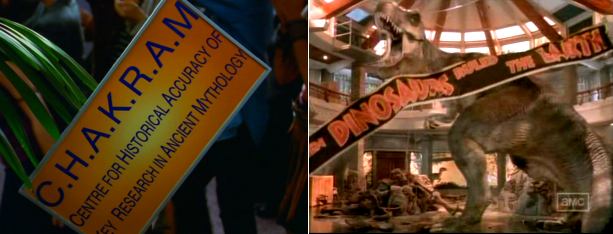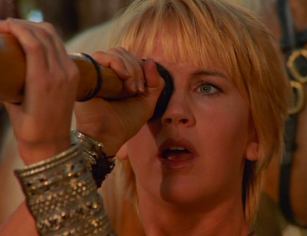| We've bid adieu to the Amazons, and now we'll do the same for The Last of the Centaurs. Unlike the Amazons, however, who have the option of melding back into society, the Centaurs have nowhere to go. Their persecutor is similar to the persecutor of To Helicon and Back:" Bellerophon, son of the Virgin Huntress, as well as the hunter Prince Morloch. Belach's name reflects this similarity, and it evokes the names of the demons from Paradise Lost as well: Moloch, the demon who oversaw child sacrifice, and the variant of his name, Bel. Lord Belach resents his warlord father, Borias, who left him and his mother to be sold into servitude while he joined evil Xena's campaign in Asia. If we recall Xena's choice in Ulysses, she refuses to let Ulysses leave his wife and son to join her on her travels, and here we see the backstory to that. Did such a backstory exist? We don't know, but it's likely, given all we've been told before about her past. The source of this story could very well be a combination of chapters 102 and 134 in The Greek Myths, in which Theseus and Hercules destroy the centaurs, and Hercules was subsequently purified for his role in the slaughter by partaking in the Lesser Mysteries of Dionysus; his sponsor was Theseus, and in this episode, Xena takes the place of Theseus. This purification took place after his twelfth labor, at the moment that Euripides sets his play, Herakles, and in Last of the Centaurs we see the head of the household waging war against his own family, until he comes to his senses. The connection of Borias with the centaurs likely comes from the inspiration for his name, Boreas, mentioned in the very first chapter of The Greek Myths. I expand on this in a separate essay on Borias's name . When Fates Collide is one of the most popular in the Xena fandom, and is considered by many to be the "true" ending to the series. As the series comes to a close, there is an increasing romantic quality to the stories, and this is due in part to the influence of medieval romances. We already saw how the arrival of Virgil's character signaled the use of these romances, particularly the story of the "Enchanted Loom." In that story, Princess Gaia had foolishly given away the enchanted loom of Virgil, but it is restored to her by an old woman she helps to heal:
When Fates Collide continues the soulmate motif from Black Orpheus. When Xena is told of Gabrielle, whom she's never met in this alternate timeline, "You don't even know her!" she replies "Yes, I do," in dialogue very similar to Orpheus's in the film. This idea of the alternate timeline seems to have originated (like many other elements on Xena) from Hercules. In the Norse arc episode, Somewhere Over The Rainbow Bridge, Hercules restores Baldar's life by changing the Norn's Book of Fate, which had been altered by the mischievous Loki. Another likely source for When Fates Collide is an episode written, but never produced: Sticks and Stones. There, Xena and Gabrielle's counterparts in the prehistoric age are the target of Alti, who wants to end their immortal soulmate relationship before it has a chance to begin--it also continues the motif of the aboriginal who can't speak. Xena's cavegirl counterpart is switched with her Greek counterpart, running amok in the streets, and we're reminded once again of the movie Altered States, where the research scientist reverts to his Cro-Magnon origins. Like that film, "Sticks and Stones shows the beginnings of religion as well, with Alti planting the seeds for future cults among the prehistoric clans. The episode ends with Alti vanquished long before she ever existed, causing everything she'd done to never have existed as well. This would be quite a long list, beginning with Xena's quest to become a Destroyer of Nations, an essential part of her character, so it may have been decided that Sticks and Stones was a concept that subtracted more from the show than it would have put in. Of course, such literal consistency is not usually a concern on the show, but this is one that is a little too prominent, and once done, it couldn't be undone: that existential story dilemma may have sent the writers back to the drawing board to figure out a way to retain it's elements without changing the basic nature of the Xenaverse, and the result would've been Gabrielle's destruction of the Loom, which reverts the world back to its course. The other elements of this story seem to have been transferred to Send in the Clones. In that episode, the concept of scientifically investigating the origins of religion from Altered States was replaced with the misguided attempt by science to recreate the past in the present seen in "Jurassic Park." Shifting a story from prehistoric times into a science fiction milieu was likely inspired by the successful translation of prehistoric Amazon High into Cleopatra 2525. The idea seems to have proven so fertile that a second episode using these elements was justified: we'll look at Soul Possession in a bit.
  Soul Possession's alternate titles were Missing Pieces and The Lost Scroll, which should alert us we are back under the influence of Sophocles' The Trackers, which inspired The Xena Scrolls. The show's concept, in which each episode is a reconstruction of a scroll fragment written by Gabrielle, is given its rightful place in the series, as the penultimate story. And the logic that governs the show is displayed here in full force: the creator of this show has "sole possession" of it; it cannot be repossessed by any other simply by extending the apparent logic of its characters' actions, because those actions do not dictate the story; it's the larger story that dictates the characters' actions, and that story cannot be known unless all of the scroll "fragments" can be discovered. The episode's action begins when two divers (like the two archaeologists in The Trackers) finding a sealed scroll underwater near a seaside cliff. This scroll proves to be the sequel to the Adventures in the Sin Trade scroll, and promises to finally answer the question of how Gabrielle and Hope escaped from their plummet into the volcano's chasm at the end of third season's Sacrifice II. I speculated before that the literal solution offered by Steve Sears was rejected, and that Rob Tapert turned to Euripides (yet again) for the answer. We can be sure the play he used was one used elsewhere many times, and the play that RJ Stewart had said was instrumental to his approach to writing for Xena: Helen. I will explore this play in greater detail in the second part of this essay, but for now, it's clear that this episode borrows Helen's ruse to get out of marriage to her captor, the King of Egypt, by accepting his proposal, then staging a burial at sea for her husband (who is quite alive, unknown to the king). After learning Gabrielle survived the fall, in Adventures in the Sin Trade, she makes a deal with Ares: he finds Gabrielle, then Xena will accept his marriage proposal. The catch is that the marriage will be an unbreakable bond, in the form of a contract. Like Helen, Xena tricks her would-be groom with a burial at sea: except it's the marriage contract that's buried at sea, not a "deceased" husband's empty shroud. There is a genuine promise of marriage in this episode, though, between Xena's look-alike, Meg, and Joxer, and this silly scene may be inspired by Aristophanes' giddy villagers in Peace, who, having rejected War, are ready to celebrate: "Here is the bride about to appear!...All who come with me shall have cakes galore!" Peace was likely a source for The Bitter Suite, so Meg's singing is a kind of satyr-like homage to that episode. Soul Possession has all the earmarks of a satyr play: the presence of scrolls filling in blanks, Xena using the bathroom, repeated flatulence, the presence of a Minya-type character, as we saw in A Day in the Life, in the form of rabid fans (similar to the group we saw in Send in the Clones), as well as references to previous satyr play episodes, such as Deja Vu All Over Again. That episode appeared at a crucial moment in the series, right after Xena and Gabrielle had been crucified, and it appears here right before Xena's body will be similarly displayed. Finally, there is the parallel with the use of The Trackers compared with its use in The Xena Scrolls: in Sophocles' play, the god who's resurrected is Apollo, but in The Xena Scrolls that's been switched to Ares. This is because The Trackers, as translated in The Trackers of Oxyrhynchus by Tony Harrison, the true liberating force is not Apollo but the followers of Dionysus, the satyrs. Ares is a Dionysiac figure: sometimes he's more like the goat-man, Silenus, but in these "Ubers" he's much more dark, the way Julius Caesar is portrayed; this is similar to how he's portrayed on Hercules, as well, and in Soul Possession, we see both sides of him. He arrives as the dark Dionysiac force, a "Wild One"-style biker, clearly a reference to the baby-stealing Leonard Snopes, from the Coen Brothers' Raising Arizona. We don't know how Ares escaped from the tomb of The Xena Scrolls back during World War II, but it doesn't matter: using the logic of The Trackers of Oxyrhynchus, the Dionysiac force is resurrected solely by the examination of the evidence he left behind, and that's what occurs here, when the lost scroll is put on display. Once Ares leaves his bike and tries to do battle with Xena, he's back in Silenus-mode, and once again the tutor is outwitted by the pupil. This episode was long anticipated by fans looking for a logical explanation for Gabrielle's survival from the fall, and we should also keep in mind that apparently at least one writer felt the lack of such an explanation was a key failing of the show. This episode tweaks those expectations by promising that all will cleared up, only to give us one of the silliest episodes in the show's entire run. It was considered so irreverent that many fans to this day refer to it as TUE--"The Unnamed Episode." To this day, I don't think there's ever been a direct admission that this episode was supposed to be anything but a serious attempt to resolve the inconsistency, but watching the dvd commentary, writer Melissa Black can barely keep from laughing as she explains why she feels it was an acceptable solution. I think that Rob Tapert learned the same lesson his erstwhile collaborators the Coen Brothers did, long ago: the best comedy is played with a straight face.  |
